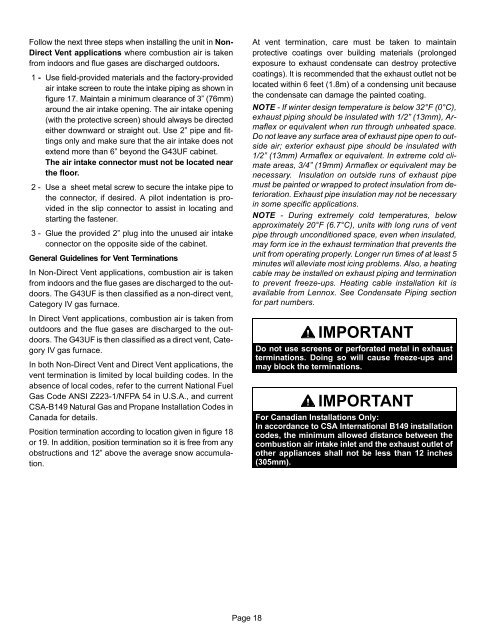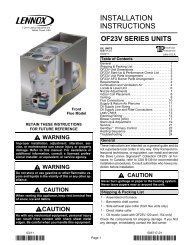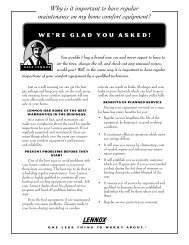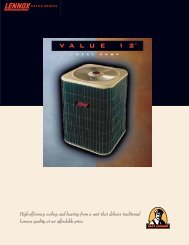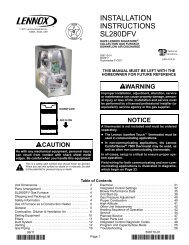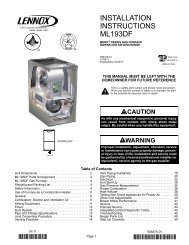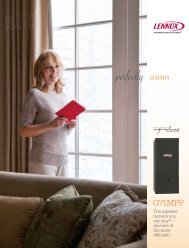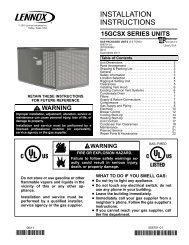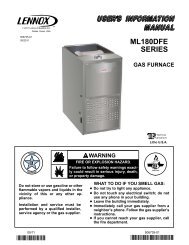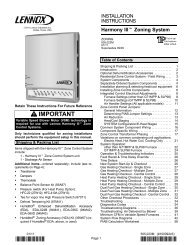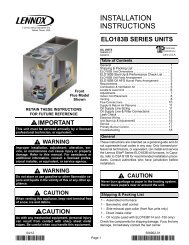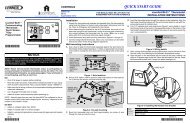INSTALLATION INSTRUCTIONS - Lennox
INSTALLATION INSTRUCTIONS - Lennox
INSTALLATION INSTRUCTIONS - Lennox
You also want an ePaper? Increase the reach of your titles
YUMPU automatically turns print PDFs into web optimized ePapers that Google loves.
Follow the next three steps when installing the unit in Non-<br />
Direct Vent applications where combustion air is taken<br />
from indoors and flue gases are discharged outdoors.<br />
1 − Use field−provided materials and the factory−provided<br />
air intake screen to route the intake piping as shown in<br />
figure 17. Maintain a minimum clearance of 3" (76mm)<br />
around the air intake opening. The air intake opening<br />
(with the protective screen) should always be directed<br />
either downward or straight out. Use 2" pipe and fittings<br />
only and make sure that the air intake does not<br />
extend more than 6" beyond the G43UF cabinet.<br />
The air intake connector must not be located near<br />
the floor.<br />
2 − Use a sheet metal screw to secure the intake pipe to<br />
the connector, if desired. A pilot indentation is provided<br />
in the slip connector to assist in locating and<br />
starting the fastener.<br />
3 − Glue the provided 2" plug into the unused air intake<br />
connector on the opposite side of the cabinet.<br />
General Guidelines for Vent Terminations<br />
In Non-Direct Vent applications, combustion air is taken<br />
from indoors and the flue gases are discharged to the outdoors.<br />
The G43UF is then classified as a non-direct vent,<br />
Category IV gas furnace.<br />
In Direct Vent applications, combustion air is taken from<br />
outdoors and the flue gases are discharged to the outdoors.<br />
The G43UF is then classified as a direct vent, Category<br />
IV gas furnace.<br />
In both Non-Direct Vent and Direct Vent applications, the<br />
vent termination is limited by local building codes. In the<br />
absence of local codes, refer to the current National Fuel<br />
Gas Code ANSI Z223−1/NFPA 54 in U.S.A., and current<br />
CSA−B149 Natural Gas and Propane Installation Codes in<br />
Canada for details.<br />
Position termination according to location given in figure 18<br />
or 19. In addition, position termination so it is free from any<br />
obstructions and 12" above the average snow accumulation.<br />
At vent termination, care must be taken to maintain<br />
protective coatings over building materials (prolonged<br />
exposure to exhaust condensate can destroy protective<br />
coatings). It is recommended that the exhaust outlet not be<br />
located within 6 feet (1.8m) of a condensing unit because<br />
the condensate can damage the painted coating.<br />
NOTE − If winter design temperature is below 32°F (0°C),<br />
exhaust piping should be insulated with 1/2" (13mm), Armaflex<br />
or equivalent when run through unheated space.<br />
Do not leave any surface area of exhaust pipe open to outside<br />
air; exterior exhaust pipe should be insulated with<br />
1/2" (13mm) Armaflex or equivalent. In extreme cold climate<br />
areas, 3/4" (19mm) Armaflex or equivalent may be<br />
necessary. Insulation on outside runs of exhaust pipe<br />
must be painted or wrapped to protect insulation from deterioration.<br />
Exhaust pipe insulation may not be necessary<br />
in some specific applications.<br />
NOTE − During extremely cold temperatures, below<br />
approximately 20°F (6.7°C), units with long runs of vent<br />
pipe through unconditioned space, even when insulated,<br />
may form ice in the exhaust termination that prevents the<br />
unit from operating properly. Longer run times of at least 5<br />
minutes will alleviate most icing problems. Also, a heating<br />
cable may be installed on exhaust piping and termination<br />
to prevent freeze−ups. Heating cable installation kit is<br />
available from <strong>Lennox</strong>. See Condensate Piping section<br />
for part numbers.<br />
IMPORTANT<br />
Do not use screens or perforated metal in exhaust<br />
terminations. Doing so will cause freeze−ups and<br />
may block the terminations.<br />
IMPORTANT<br />
For Canadian Installations Only:<br />
In accordance to CSA International B149 installation<br />
codes, the minimum allowed distance between the<br />
combustion air intake inlet and the exhaust outlet of<br />
other appliances shall not be less than 12 inches<br />
(305mm).<br />
Page 18


